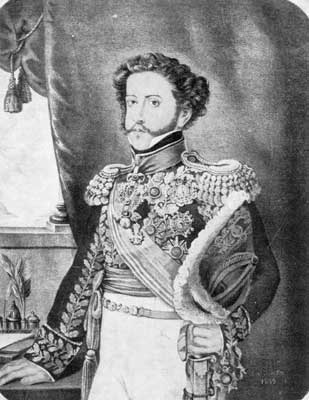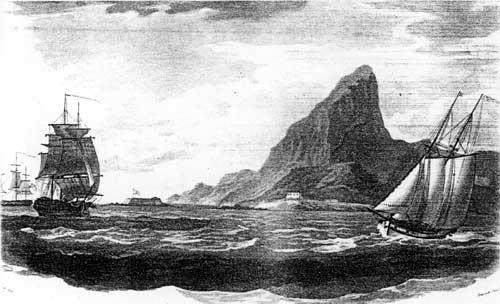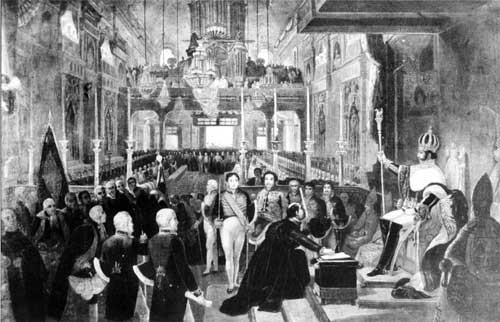 |
|
The Emperor Pedro I of Brazil |
Recruitment in
London
and Liverpool presented few problems. There were a sufficient
number of hardy souls willing to exchange the chilling fogs of
the European winter for service in the sun, good pay and prize
money. The salary scales of the Brazilian Navy may have been
generous for seamen, but for officers they were less so. £8 a
month for lieutenants and £5 for sub‑lieutenants were only
two‑thirds of the rates paid in the Royal Navy, but the
comparison meant little to men who had long since abandoned
all hope of ever serving again under the British flag.
Furthermore, the contracts offered by the Brazilian Agent were
attractive. Each officer was to sign on for five years - if at
the end of that time he remained in the service he would
receive an extra 50 per cent in addition to his normal salary;
if he returned to Britain he would receive Brazilian half‑pay
for the rest of his life. Free passages were provided and pay
was to commence from the date of embarkation.
[4] All the
officers recruited by Thompson had previously served in the
Royal Navy. Vincent Crofton, Samuel Chester, Francis Clare and
Richard Phibbs had been midshipmen but had passed the
examination for lieutenant and were appointed as such. The
fifth, Benjamin Kelmare, had served with Cochrane in Chile
where he had been wounded in the attack on the Esmeralda.
He was commissioned as a commander.
[5]
The first recruiting exercise was a complete success and was
conducted in strict secrecy to escape the attentions of the
British authorities and the Portuguese consuls. To avoid
detection under the Foreign Enlistment Act of 1819, Brant
maintained the fiction that the recruits were settlers
emigrating to Brazil, and carefully described the seamen in
official documents as 'farm labourers' and the officers as
'overseers'. The authorities must however have colluded in
this deception since in dress, language and gait, seamen were
such a distinctive group that they could not have been
mistaken!
At the end of January 1823, the first party of 125 men and six
officers left Liverpool on the Lindsays to be followed
three days later by a second group of forty-five seamen who
left London on the Lapwing.
[6] On arrival in Rio, the
officers were distributed among the most powerful ships in the
squadron [7] while the seamen were signed on and allowed
ashore for the first time in six weeks. Within a few hours of
exposure to all the pleasures of a foreign port, the majority
were gloriously drunk. When some officers complained to the
Empress, it is reported that she laughed and said 'Oh, 'tis
the custom of the north where brave men come from. The sailors
are under my protection; I spread my mantle over them!’[8]
Lieutenant Phibbs was found to be medically unfit, but the
vacancy was easily filled by the recruitment of John Nicol and
William Parker, Mates respectively of the Lapwing and
the Lindsays. [9]
Brant reported on the success of his efforts with undisguised
satisfaction. The cost of recruitment in
London
had been reasonable and the men had accepted monthly pay of
just £2. In Liverpool on the other hand, the 'perfidious'
Meirelles had ignored his instructions and had not only
offered £5.50 a month but, disregarding the need for secrecy,
had 'criminally and unnecessarily' signed a contract to that
effect. Brant reported hotly that on being reprimanded on the
excessive offer of pay, the Vice‑Consul had merely retorted
that when the men were in
Rio
and the government could pay what it liked.
[10]
|

The
entrance to the Bay of Guanabara showing the Sugar Loaf
(Naval Chronical, 1808) |
Nevertheless, news of Portuguese reinforcements continued to
arrive and when in March, officers of the HMS Conway,
recently returned from
Brazil,
reported that the navy was still hampered by a lack of men,
Brant determined to launch a second recruiting campaign.
[11]
He and Meirelles went into action, and within six weeks had
found 265 seamen and fourteen officers, all of whom had
previously served in the Royal Navy. This time the officers
were engaged through the agency of Captain James Norton, a
34-year-old English officer with aristocratic connections who
had fought in the Napoleonic Wars with the Royal Navy and had
then served with the East India Company. Norton was
commissioned as a frigate captain, while five of his
companions ‑ John Rogers Gleddon, George Clarence, Charles
Mosselyn, Samuel Gillett and Raphael Wright ‑ became
lieutenants. The more junior recruits ‑ Duncan Macreights,
George Broom, George Cowan, Ambrose Challes, Charles Watson,
William George Inglis, and James Watson ‑ were appointed as
sub‑lieutenants. [12] Together with officers and seamen, the
party also included petty officers and boatswains as well as
thirty-one young men who signed on as Master’s Mates or
Volunteers in the hope of eventually gaining promotion to the
quarter deck. They were not disappointed; within a year,
almost all had been appointed as sub‑lieutenants.
[13]
Having staffed and fitted out his ships, in April 1823
Cochrane led the Brazilian Navy out of Rio de Janeiro on a cruise of astonishing audacity
and success. In a campaign of only six months he blockaded and
expelled a Portuguese army and a greatly superior naval
squadron from its base in
Bahia, then harried it out of Brazilian waters and across the
Atlantic. He then tricked the Portuguese garrisons into
evacuating Maranhão and Belém, leaving the
northern provinces
free to pledge allegiance to the Empire. By the end of the
year, the country had rid itself of all Portuguese troops and
was, to all intents and purposes, independent. If 1823 was the
year of victory for the Brazilian Navy, 1824 was the year of
consolidation. Cochrane’s men first deployed themselves in
preventing any Portuguese counter-invasion, then co-operated
with the army in defeating a dangerous north-eastern rebellion
known as the Confederation of the Equator.
[14]
The War of Independence had also seen a dramatic increase in
the size of the Brazilian navy. In 1823, it had comprised just
twenty-eight warships and schooners carrying a total of 382
guns. A year later as a result of captures and further
purchases it had grown to forty-eight vessels with 620 guns.
The expansion was spectacular, but it meant that once again
the government was short of junior officers and men. The
experience of foreign recruitment in 1823 had however been
highly satisfactory. Desertions had been minimal; of the
fifty-eight British officers or aspiring officers recruited in
England and locally, only thirteen had deserted their posts.
Crosbie had left with Cochrane to seek their fortunes in
Greece; James Watson and Samuel Gillett had deserted; Joseph
Sewell, Thomas Poynton and John Rogers Molloy had been
dismissed; Commander Benjamin Kelmare and Sub-lieutenants
Blakely and Macreights had quietly left the service; and
Lieutenants Chester, Challes and Mosselyn had died or become
invalids, a relatively small proportion in view of the
diseases prevalent on overcrowded ships in the tropics.
|

The Coronation of Pedro I in 1822
(J.B. Debrett) |
Encouraged by its initial success, the Brazilian Government
mounted a second recruiting campaign in 1825. General Brant in
London was ordered to find eight hundred seamen and eighteen
officers below the rank of commander and to buy two frigates
and two armed steamships.
[15] This time, in spite of pay
increases for both officers and men, the task was more
difficult. Brant and his new colleague Gameiro managed to find
eleven officers, but this time only two ‑ Lieutenant Thomas
Haydon and Midshipman Louis Brown, cousin of the
Irish-Austrian General Gustavo Brown who had transferred to
the Brazilian service ‑ were British, the rest were French or
Scandinavian. [16] Seamen were easier to find, and by the end
of 1825, about four hundred were on their way – just in time
for
Brazil’s
war with Buenos Aires. [17]
The war between
Brazil
and the United Provinces of the River Plate was fought out by
small squadrons in the channels and mud‑flats of the river and
by individual warships engaging the Argentine privateers who
were unleashed along the Brazilian coast. One of the
curiosities of the war – in which British trade was a major
victim – was that the navies of both sides were substantially
commanded and manned by men from England, Ireland and
Scotland. On the Brazilian side Commodore Norton, who
lost his arm in the process, commanded the inshore squadron in the river and led it to
minor victories, backed by ships commanded by Bartholomew
Hayden, Francis Clare and William James Inglis. John Pascoe Grenfell, Thomas Craig and
George Broom all distinguished themselves as commanders in
single ship actions. Not all survived; Lieutenant John Rogers Gleddon and Sub-lieutenant Charles Yell were killed at sea,
while Captain James Shepherd died leading a disastrous attack
in
Patagonia. The navy quietly dispensed with the services of
four more, Sub‑lieutenant Gore Whitlock Oudesley and
Lieutenant David Carter for being drunk during the capture of
their corvette in 1827; Lieutenant Vincent Crofton,
graphically described by his commanding officer as 'a madman
and a drunkard'; and Commander Alexander Reid for sheer
incompetence. In 1827, Sub‑lieutenant Robert Mackintosh seized
control of the schooner he commanded with the help of
Argentine prisoners and sailed it to
Buenos Aires.
There he sold it to the government and pocketed the proceeds.
The war inevitably served as a powerful stimulant to the
growth of the Brazilian Navy By 1828, it was the biggest in
the Americas and had grown to one ship-of-the-line, nine
frigates, sixty-six smaller warships and two armed steamships
carrying 875 guns. The personnel consisted of about 8,400
officers and men, of whom no less than 1,200 were natives of
Britain and Ireland. [18] The advantages of this arrangement
were clear, yet so too were the problems. There had been, for
example, instances of groups of captured seamen changing sides
rather than face unpaid imprisonment. A minor revolution in
1831 and the abdication of Emperor Pedro brought a government
to power in Brazil which believed in economies and
retrenchment. The navy which was cut to one-fifth of its
former size and was firmly recast in the role it was to play
for the rest of the century, that of regional policeman and
coastguard. When it eventually went to war, first against the
Argentine dictator Juan Manuel de Rosas in 1852, and then
against Paraguay as part of the Triple Alliance with Argentina
and Uruguay in 1865, its field of glory lay not on the ocean
but in seizing control of the great internal rivers of South
America.
|




